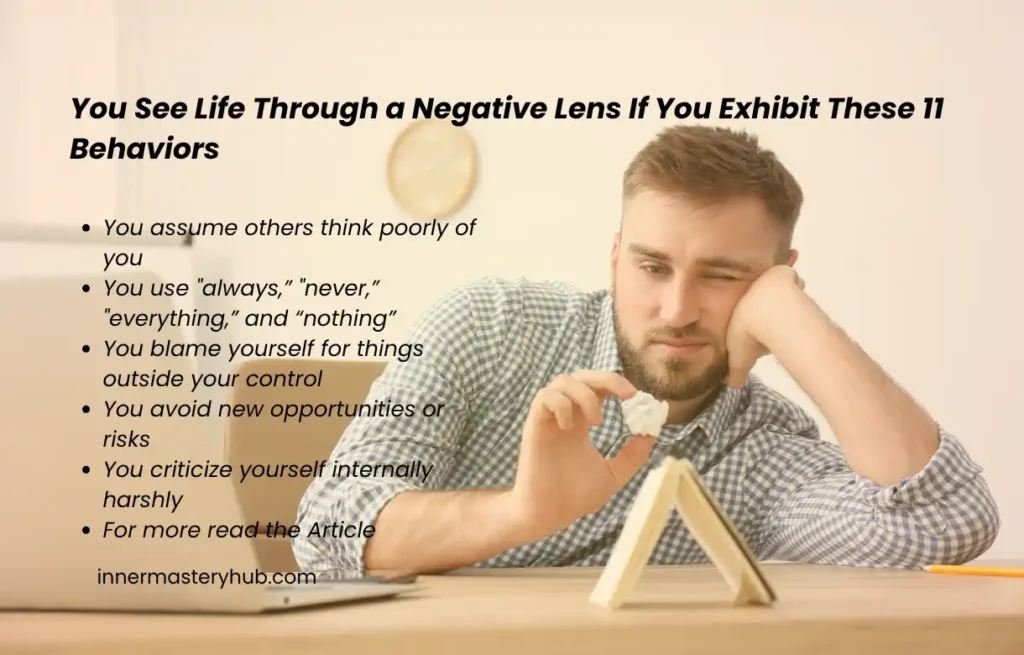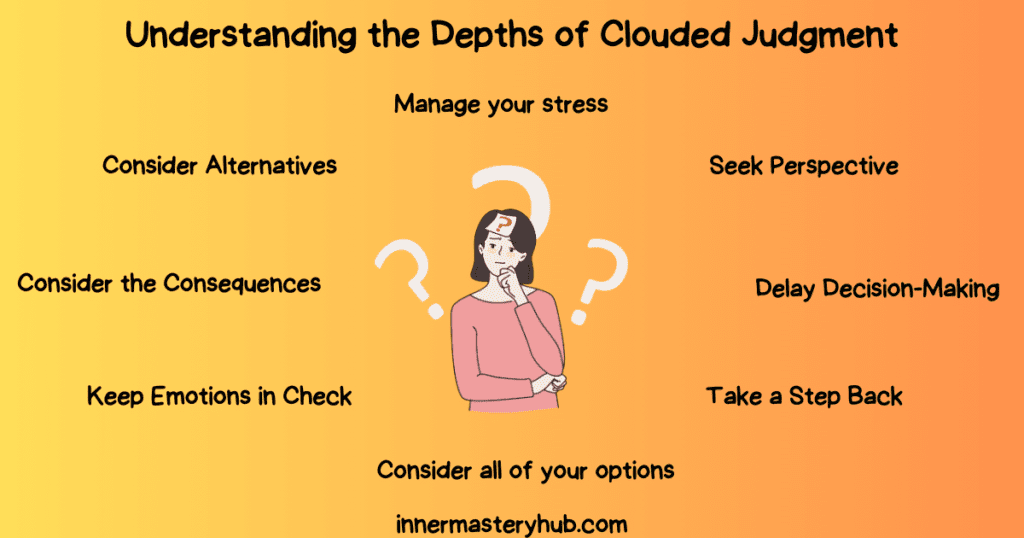You See Life Through a Negative Lens If You Avoid These 11 Behaviors

Ever questioned whether your outlook on life is gloomy? 11 habits indicate a grim outlook on life, which can subtly damage your mindset, relationships, and possibilities. These patterns show a continuous negativity. If you see several of them in yourself, you may filter life through skepticism, doubt, and defeat before giving it a chance.
Why do so many see life through a negative lens?
A lot of people use an invisible filter. That filter highlights threats, mistakes, and wrongdoing. Nowadays, it is nearly common to think negatively because of the media, social comparison, and stressful situations. As a Survival trait, humans have evolved to perceive danger more acutely than rewards. More attention is drawn to a negative lens than to a favorable lens. We refer to that as the “negativity bias.” (We place greater value on bad experiences than on good ones.)
Many of our skewed thought patterns are referred to as cognitive distortions by cognitive psychology. Mental filtering (only perceiving through a negative lens), overgeneralization, catastrophizing, labeling, personalizing, and all-or-nothing thinking are a few examples.
According to depression theory, people who have a negative lens think negatively about themselves, the world, and the future. Aaron Beck’s cognitive triad characterizes this.
People who function under those distortions “see life that way,” making the negative lens nearly invisible to them. The following behaviors are obvious indicators that the lens is in action.
The cost of seeing life through a negative lens
That negative lens does damage. It can heighten anxiety, reduce resilience, harm relationships, interrupt creativity, and lead to self-fulfilling prophecies. Persistent thinking through a negative lens is linked with depression, poorer mental health, and lower life satisfaction. A 2019 study found that negative cognitive bias (tendency to attend to negative information) is strongly linked with depressive symptoms. (PMC)
When you interpret ambiguous situations pessimistically, you block possibilities. Other people avoid you because constant negativity drains them. Over time, you may shrink your world—avoiding risks, pulling back socially, giving up on goals. These behaviors are not just self-improvement fluff: it’s protection of your mind, your relationships, and your potential.
11 Behaviors Show You See Life Through a Negative Lens
Below are the 11 behaviors. If you notice several of these in yourself, that is a red flag that your lens is skewed.
1. You focus on the worst possible outcome (catastrophizing)
You imagine disasters, failure, worst cases. When a small problem arises, your mind jumps to “What if this ruins everything?” That way of thinking increases stress and drains your energy.
2. You dismiss or discount positives
You ignore good things in your life. For example, when someone compliments you, you shrug it off and don’t realize that they were just being polite. You filter out all positive feedback.
3. You ruminate on negatives long after they pass
You replay mistakes, repeat what someone said in your mind, and chew on something you regret. That obsessive internal loop intensifies the negative lens.
4. You assume others think poorly of you
You take neutral or ambiguous social cues as judgment. If someone doesn’t immediately reply, your mind says, “They hate me” or “I annoyed them.”
5. You compare unfavorably with others constantly
You scroll social media and feel you come up short. You ignore your progress by comparing it to someone else’s highlight reel.
6. You use “always,” “never,” “everything,” and “nothing” in your speech
You speak in absolutes: “I always mess things up,” “Nothing ever works out for me.” That black-and-white language shows the negative lens through which it is framed.
7. You blame yourself for things outside your control
You take responsibility for outcomes you didn’t fully influence. You feel guilt or fault when it’s more nuanced.
8. You avoid new opportunities
You try to play it safe to avoid disappointment. You avoid applying for that job, inviting someone out, or starting a project, because of fear of a negative outcome.
9. You criticize yourself internally harshly
Your inner voice is harsh. You label yourself “stupid,” “useless,” “failure.” You rarely show yourself kindness internally.
10. You mirror negativity around you
You notice negative news more, attract negative people, or unconsciously engage in negative conversations. You reinforce your negative lens by surrounding yourself with it.
11. You resist feedback or the possibility for change
You assume your current view must be correct, so you avoid hearing alternative interpretations and resist the idea that you might be biased. These behaviors closely map onto cognitive distortions studied by psychologists.

Why these behaviors stick
These behaviors become habits because:
- Habitual patterns are rewarded by the brain (negative scanning becomes default).
- Confirmation bias gets worse in the presence of negative emotions (you notice what fits your lens).
- Conditioning loops occur when negative thinking results in unfavorable events or withdrawal.
- The idea that “people are against me” is strengthened by social input, such as unfavorable reactions or others’ withdrawal.
Moreover, you may not even notice the lens. It feels like reality. You forget that interpretations are optional.
How to shift the negative lens
Changing a lens is gradual. Below are steps I’ve used (and refined over the years) that help rewire perspective.
1. Start noticing the behaviors (awareness)
Carry a pen or open a notes app. When one of the 11 behaviors surfaces, jot it down: “I discounted praise,” “I assumed the worst.” Build awareness. The moment of noticing is the first pivot.
2. Name the distortion
Match the behavior to a known distortion: catastrophizing, filtering, labeling, or overgeneralizing. Naming it gives distance. You say, “Oh, that’s catastrophizing again,” not “That’s just me.”
3. Ask evidence questions
For each negative thought, ask:
- What evidence supports this thought of mine?
- What evidence opposes it?
- Is there an alternative, more balanced interpretation?
This is fundamental cognitive reframing. A recent study on reframing negative thoughts showed that more empathic and specific reframes are preferred. (arXiv)
4. Shift your internal language
Replace “always,” “never,” “everything” with “sometimes,” “occasionally,” “some.” Use neutral statements before interpreting. Example: “They were late” instead of “They hate me.”
5. Practice positive and neutral seeking
Consciously focus on neutral or positive observations. Journal three neutral/good things each day (no judgment). Over time, you will be able to build a counterbalance to the filter.
6. Incremental exposures to uncertainty
Deliberately take small risks (invite someone, try something new). When you survive uncertainty, you weaken the fear of negative outcomes.
7. Surround yourself with balanced voices
Choose media and people who offer nuanced views (not always optimism, but realistic) and try to limit exposure to negative news or commentary.
8. Seek feedback from trusted people
Ask a friend: “Was I being unfair in that thought?” External perspectives help you see your lens.
9. Use mindfulness or metacognitive distance
With mindfulness practice, you can see thoughts as passing events rather than reality. You observe “I’m having the thought that…” rather than identify it as your reality.
10. Track progress, not perfection
Every time you resist one of the 11 behaviors, note it as a win. The lens change process is gradual, so don’t push.
11. Consider therapy or coaching
If the negative lens is deeply ingrained or tied to trauma or depression, professional support can guide you through a more in-depth rewiring.
Summary & Final Thoughts
It is not unusual to view life negatively. You have a choice, though, if those 11 habits indicate that you view the world negatively.
The issue is that learned filters, cognitive distortions, and negative bias are ordinary in human cognition.
That perspective decreases self-confidence, relationships, growth, and mood. Awareness, identifying distortions, rephrasing, language change, exposure, feedback, mindfulness, and, if necessary, expert assistance are the solutions.
Nobody suddenly changes their perspective. However, you broaden your vision every time you stop and ask yourself, “Is that a negative filter or reality?” You make room for more nuanced, hopeful, and balanced meaning with regular practice.
FAQs About “See Life Through A Negative Lens”
What does it mean to “see life through a negative lens”?
It means your ingrained perspective on life places greater emphasis on the negatives—threats, defects, and hazards—than on the positives. You tend to view confusing situations negatively, often due to underlying biases or cognitive distortions.
Are these 11 behaviors tied to any psychological theory?
Yes. Cognitive distortions, and many of them overlap (from cognitive behavioral therapy). These distortions—typical negative thinking flaws, including filtering, personalizing, overgeneralization, and catastrophizing—describe them.
If I notice 3 or 4 of these behaviors in myself, does that mean I have a pessimistic worldview?
Though not always entirely, it is a red flag. There is usually a continuum of these behaviors. Several repeated observations indicate that the negative lens is active and should be adjusted.
Can someone permanently shift out of a negative lens, or is it just temporary fixes?
Long-term change is possible, but it requires constant work. Over time, you can rewire your default lens through awareness, reframing, behavioral trials, feedback, and potentially treatment.
Will focusing on positivity ignore real problems?
No, if you strike a balance between optimism and realism. The aim is less distortion, not naive optimism. You continue to recognize genuine difficulties, but you don’t exaggerate them needlessly or disregard contradicting data.
How long does it take to change a negative lens?
Depending on how deeply ingrained these patterns are, yes. Weeks of intentional practice may be enough to bring about changes in mild habitual negativity. Months or even years of work may be required for deeper issues (trauma, chronic depression).
Can this negative lens behavior be inherited or from upbringing?
Indeed. How children perceive the world is shaped by their early environment, modeling, trauma, and conditioning. Genetic predispositions, such as an inclination toward anxiety, can facilitate the development of negative lens features.
Are there tools or exercises to test whether I have a negative lens?
Indeed. Journaling (keeping track of automatic negative thoughts), thought diaries, cognitive distortion guided questionnaires, or asking trusted people to identify repeated negative patterns you might overlook are all options.
When should I see a professional (therapist, counselor) instead of self-help?
Professional assistance is recommended if the negative lens is significantly affecting your day-to-day life, such as through chronic despair, severe self-doubt, avoidance, relationship problems, or trauma triggers. While self-help is helpful, experts can help with more in-depth processing and healing.





